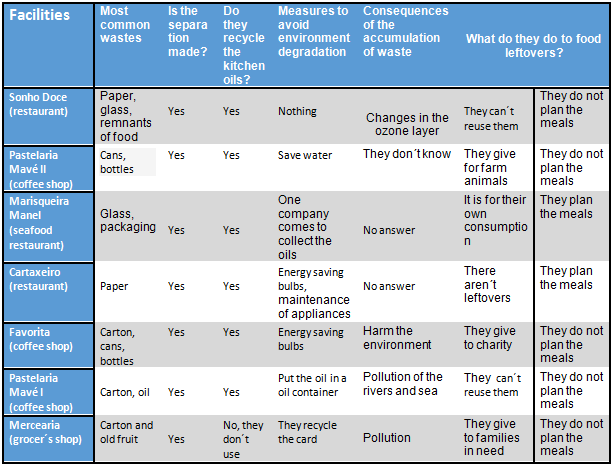In Portugal, according to Eurostat (2016), 14 184 tonnes of garbage were dumped in 2012.Excessive consuming, overproduction, bad storage and inappropriate conservation of the food are the main causes of Food wastes. There are other reasons of wastage of food, for example, the restaurants don´t know how to reuse their leftovers; and the people order more food than they need and it´s wasted (Wikipedia, 2016).
Can this problem be avoided?
Fortunately, this problem can be avoided. Everyone should recycle everything that can be recycled,and the restaurants should minimize the impact of food waste by planning the meals. It is also important to reuse the leftovers, preserving the food. Besides, reducing, reusing and recycling we must ask for tmore awareness campaigns (eba, 2012)
According to the most common wastes are the water, any rubbish that we make in our homes and other places, the seeds, the roots, the lamps, the batteries, paper, cans, glass, bottles, packaging and finally the food. We must put the packages in the right eco containers and the barks and the roots serve to fertilize the soil (eSchoolToday, 2008)
One of the most common waste is kitchen oil, and it is considered one of the most difficult wastes to be reused. But it is possible. According to Reciol (2010), for example, after being recycled, it can be used in chemical industries to produce soap, detergent, paints and biodiesel.
Are people really aware of the impact of Waste?
We did some surveys, aiming to get data from restaurants, coffee shops and greengrocers’. We have enquired several facilities, inCaneças, here are some of the results:
What do facilities do about food waste?
In all these restaurants the most common wastes are carton, cans and paper, which corresponds to the results of our research.
Besides, all of them have a correct waste selection including the correct oil collection.
Furthermore, Pastelaria Mavé II saves water, but Marisqueira Manel sends oil to a company for being recycled, which is much better for the environment.
Yet, besides doing what the law demands – the correct selection of waste – few seem to be aware of their role to protect the environment, because most of them didn´t answer our question (Consequences of the accumulation of waste) or just gave one or two examples.
Moreover, we could understand that some of them don´t know what to do with the leftovers but they try to avoid this issue. For example, Favorita sends food to charity, Pastelaria Mavé II gives food for farm animals but Sonho Doce doesn´t know how to reuse them.
With the last column of the table, we conclude that the majority of the restaurants, in this village, can´t plan the meals. And according to epa (2012), planning meals is essential for saving money and reducing wastes of food.
What we think about all of this?
In our poor world we do not give the next generations the opportunity to enjoy the world´s conditions. So what are we doing? Can you imagine your sons and daughters living in that rubbish that we leave behind? Would you like if it happened to you?
So do everything that you can do change the world.
That´s why it´s time to protect the environment and be eco-friendly.
To conclude, food waste is a global issue and that´s why the governments should have a more efficient intervention to prevent the wastage of food. Yet, there are good news:
we are surprised with our interviews because we didn´t know that the restaurants of Caneças do so much to protect the environment.




You must be logged in to post a comment.